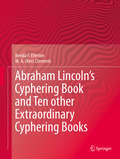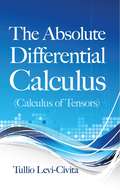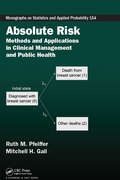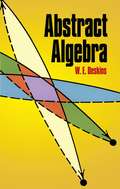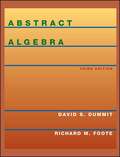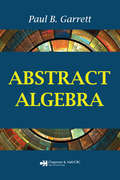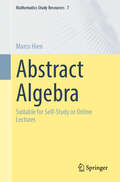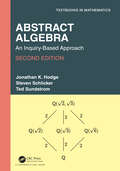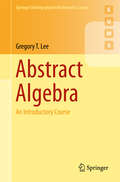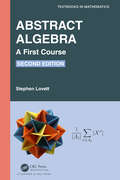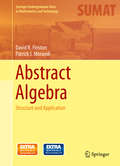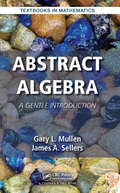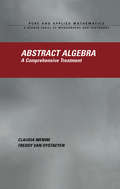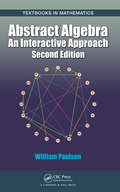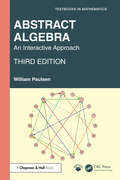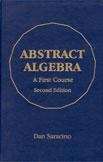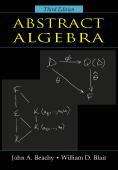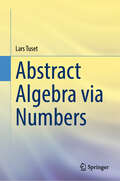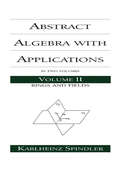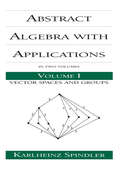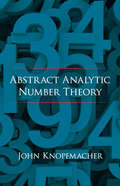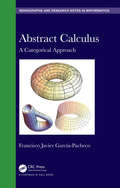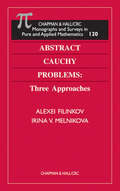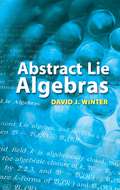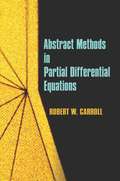- Table View
- List View
Abraham Lincoln’s Cyphering Book and Ten other Extraordinary Cyphering Books
by M. A. Ken Clements Nerida F. EllertonThis well-illustrated book provides strong qualitative and comparative support for the main arguments developed by Nerida Ellerton and Ken Clements in their groundbreaking Rewriting this History of School Mathematics in North America 1607-1861: The Central Role of Cyphering Books. Eleven extraordinary handwritten school mathematics manuscripts are carefully analyzed--six were prepared entirely in Great Britain, four entirely in North America, and 1 partly in Great Britain and partly in North America. The earliest of the 11 cyphering books was prepared around 1630, and the latest in 1835. Seven of the manuscripts were arithmetic cyphering books; three were navigation cyphering books, and one was a mensuration/surveying manuscript. One of the cyphering books examined in this book was prepared, over the period 1819-1826, by a young Abraham Lincoln, when he was attending small one-teacher schools in remote Spencer County, Indiana. Chapter 6 in this book provides the first detailed analysis of young Abraham's cyphering book--which is easily the oldest surviving Lincoln manuscript. Another cyphering book, this one prepared by William Beattie in 1835, could have been prepared as a special gift for the King of England. The analyses make clear the extent of the control which the cyphering tradition had over school mathematics in North America and Great Britain between 1630 and 1840. In their final chapter Ellerton and Clements identify six lessons from their research into the cyphering tradition which relate to present-day circumstances surrounding school mathematics. These lessons are concerned with sharp differences between intended, implemented and attained curricula, the remarkable value that many students placed upon their cyphering books, the ethnomathematical circumstances which surrounded the preparations of the extraordinary cyphering books, and qualitative differences between British and North American school mathematics.
The Absolute Differential Calculus: Calculus Of Tensors (Dover Books on Mathematics)
by Tullio Levi-CivitaWritten by a towering figure of twentieth-century mathematics, this classic examines the mathematical background necessary for a grasp of relativity theory. Tullio Levi-Civita provides a thorough treatment of the introductory theories that form the basis for discussions of fundamental quadratic forms and absolute differential calculus, and he further explores physical applications.Part one opens with considerations of functional determinants and matrices, advancing to systems of total differential equations, linear partial differential equations, algebraic foundations, and a geometrical introduction to theory. The second part addresses covariant differentiation, curvature-related Riemann's symbols and properties, differential quadratic forms of classes zero and one, and intrinsic geometry. The final section focuses on physical applications, covering gravitational equations and general relativity.
Absolute Risk: Methods and Applications in Clinical Management and Public Health (Chapman & Hall/CRC Monographs on Statistics and Applied Probability)
by Ruth M. Pfeiffer Mitchell H. GailAbsolute Risk: Methods and Applications in Clinical Management and Public Health provides theory and examples to demonstrate the importance of absolute risk in counseling patients, devising public health strategies, and clinical management. The book provides sufficient technical detail to allow statisticians, epidemiologists, and clinicians to build, test, and apply models of absolute risk. Features: Provides theoretical basis for modeling absolute risk, including competing risks and cause-specific and cumulative incidence regression Discusses various sampling designs for estimating absolute risk and criteria to evaluate models Provides details on statistical inference for the various sampling designs Discusses criteria for evaluating risk models and comparing risk models, including both general criteria and problem-specific expected losses in well-defined clinical and public health applications Describes many applications encompassing both disease prevention and prognosis, and ranging from counseling individual patients, to clinical decision making, to assessing the impact of risk-based public health strategies Discusses model updating, family-based designs, dynamic projections, and other topics Ruth M. Pfeiffer is a mathematical statistician and Fellow of the American Statistical Association, with interests in risk modeling, dimension reduction, and applications in epidemiology. She developed absolute risk models for breast cancer, colon cancer, melanoma, and second primary thyroid cancer following a childhood cancer diagnosis. Mitchell H. Gail developed the widely used "Gail model" for projecting the absolute risk of invasive breast cancer. He is a medical statistician with interests in statistical methods and applications in epidemiology and molecular medicine. He is a member of the National Academy of Medicine and former President of the American Statistical Association. Both are Senior Investigators in the Division of Cancer Epidemiology and Genetics, National Cancer Institute, National Institutes of Health.
Abstract Algebra (Dover Books on Mathematics)
by W. E. DeskinsThis excellent textbook provides undergraduates with an accessible introduction to the basic concepts of abstract algebra and to the analysis of abstract algebraic systems. These systems, which consist of sets of elements, operations, and relations among the elements, and prescriptive axioms, are abstractions and generalizations of various models which evolved from efforts to explain or discuss physical phenomena.In Chapter 1, the author discusses the essential ingredients of a mathematical system, and in the next four chapters covers the basic number systems, decompositions of integers, diophantine problems, and congruences. Chapters 6 through 9 examine groups, rings, domains, fields, polynomial rings, and quadratic domains.Chapters 10 through 13 cover modular systems, modules and vector spaces, linear transformations and matrices, and the elementary theory of matrices. The author, Professor of Mathematics at the University of Pittsburgh, includes many examples and, at the end of each chapter, a large number of problems of varying levels of difficulty.
Abstract Algebra
by David S. Dummit Richard M. FooteThis revision of Dummit and Foote's widely acclaimed introduction to abstract algebra helps students experience the power and beauty that develops from the rich interplay between different areas of mathematics. The book carefully develops the theory of different algebraic structures, beginning from basic definitions to some in-depth results, using numerous examples and exercises to aid the student's understanding. With this approach, students gain an appreciation for how mathematical structures and their interplay lead to powerful results and insights in a number of different settings. <P><P> The text is designed for a full-year introduction to abstract algebra at the advanced undergraduate or graduate level, but contains substantially more material than would normally be covered in one year. Portions of the book may also be used for various one-semester topics courses in advanced algebra, each of which would provide a solid background for a follow-up course delving more deeply into one of many possible areas: algebraic number theory, algebraic topology, algebraic geometry, representation theory, Lie groups, etc.
Abstract Algebra
by Paul B. GarrettDesigned for an advanced undergraduate- or graduate-level course, Abstract Algebra provides an example-oriented, less heavily symbolic approach to abstract algebra. The text emphasizes specifics such as basic number theory, polynomials, finite fields, as well as linear and multilinear algebra. This classroom-tested, how-to manual takes a more narra
Abstract Algebra: Suitable for Self-Study or Online Lectures (Mathematics Study Resources #7)
by Marco HienThis book contains the basics of abstract algebra. In addition to elementary algebraic structures such as groups, rings and solids, Galois theory in particular is developed together with its applications to the cyclotomic fields, finite fields or the question of the resolution of polynomial equations.Special attention is paid to the natural development of the contents. Numerous intermediate explanations support this basic idea, show connections and help to better penetrate the underlying concepts. The book is therefore particularly suitable for learning algebra in self-study or accompanying online lectures.
Abstract Algebra: An Inquiry-Based Approach (Textbooks in Mathematics)
by Jonathan K. Hodge Steven Schlicker Ted SundstromAbstract Algebra: An Inquiry-Based Approach, Second Edition not only teaches abstract algebra, but also provides a deeper understanding of what mathematics is, how it is done, and how mathematicians think. The second edition of this unique, flexible approach builds on the success of the first edition. The authors offer an emphasis on active learning, helping students learn algebra by gradually building both their intuition and their ability to write coherent proofs in context. The goals for this text include: Allowing the flexibility to begin the course with either groups or rings. Introducing the ideas behind definitions and theorems to help students develop intuition. Helping students understand how mathematics is done. Students will experiment through examples, make conjectures, and then refine or prove their conjectures. Assisting students in developing their abilities to effectively communicate mathematical ideas. Actively involving students in realizing each of these goals through in-class and out-of-class activities, common in-class intellectual experiences, and challenging problem sets. Changes in the Second Edition Streamlining of introductory material with a quicker transition to the material on rings and groups. New investigations on extensions of fields and Galois theory. New exercises added and some sections reworked for clarity. More online Special Topics investigations and additional Appendices, including new appendices on other methods of proof and complex roots of unity. Encouraging students to do mathematics and be more than passive learners, this text shows students the way mathematics is developed is often different than how it is presented; definitions, theorems, and proofs do not simply appear fully formed; mathematical ideas are highly interconnected; and in abstract algebra, there is a considerable amount of intuition to be found.
Abstract Algebra: An Introductory Course (Springer Undergraduate Mathematics Series #First Edition)
by Gregory T. Lee<P>This carefully written textbook offers a thorough introduction to abstract algebra, covering the fundamentals of groups, rings and fields. <P> The first two chapters present preliminary topics such as properties of the integers and equivalence relations. The author then explores the first major algebraic structure, the group, progressing as far as the Sylow theorems and the classification of finite abelian groups. An introduction to ring theory follows, leading to a discussion of fields and polynomials that includes sections on splitting fields and the construction of finite fields. The final part contains applications to public key cryptography as well as classical straightedge and compass constructions. <P> Explaining key topics at a gentle pace, this book is aimed at undergraduate students. It assumes no prior knowledge of the subject and contains over 500 exercises, half of which have detailed solutions provided.
Abstract Algebra: A First Course (Textbooks in Mathematics)
by Stephen LovettWhen a student of mathematics studies abstract algebra, he or she inevitably faces questions in the vein of, "What is abstract algebra" or "What makes it abstract?" Algebra, in its broadest sense, describes a way of thinking about classes of sets equipped with binary operations. In high school algebra, a student explores properties of operations (+, −, ×, and ÷) on real numbers. Abstract algebra studies properties of operations without specifying what types of number or object we work with. Any theorem established in the abstract context holds not only for real numbers but for every possible algebraic structure that has operations with the stated properties. This textbook intends to serve as a first course in abstract algebra. The selection of topics serves both of the common trends in such a course: a balanced introduction to groups, rings, and fields; or a course that primarily emphasizes group theory. The writing style is student-centered, conscientiously motivating definitions and offering many illustrative examples. Various sections or sometimes just examples or exercises introduce applications to geometry, number theory, cryptography and many other areas. This book offers a unique feature in the lists of projects at the end of each section. the author does not view projects as just something extra or cute, but rather an opportunity for a student to work on and demonstrate their potential for open-ended investigation. The projects ideas come in two flavors: investigative or expository. The investigative projects briefly present a topic and posed open-ended questions that invite the student to explore the topic, asking and to trying to answer their own questions. Expository projects invite the student to explore a topic with algebraic content or pertain to a particular mathematician’s work through responsible research. The exercises challenge the student to prove new results using the theorems presented in the text. The student then becomes an active participant in the development of the field.
Abstract Algebra: Structure and Application (Springer Undergraduate Texts in Mathematics and Technology)
by Patrick J. Morandi David R. FinstonThis text seeks to generate interest in abstract algebra by introducing each new structure and topic via a real-world application. The down-to-earth presentation is accessible to a readership with no prior knowledge of abstract algebra. Students are led to algebraic concepts and questions in a natural way through their everyday experiences. Applications include: Identification numbers and modular arithmetic (linear) error-correcting codes, including cyclic codes ruler and compass constructions cryptography symmetry of patterns in the real plane Abstract Algebra: Structure and Application is suitable as a text for a first course on abstract algebra whose main purpose is to generate interest in the subject or as a supplementary text for more advanced courses. The material paves the way to subsequent courses that further develop the theory of abstract algebra and will appeal to students of mathematics, mathematics education, computer science, and engineering interested in applications of algebraic concepts.
Abstract Algebra: A Gentle Introduction (Textbooks in Mathematics)
by Gary L. Mullen James A. SellersAbstract Algebra: A Gentle Introduction advantages a trend in mathematics textbook publishing towards smaller, less expensive and brief introductions to primary courses. The authors move away from the ‘everything for everyone’ approach so common in textbooks. Instead, they provide the reader with coverage of numerous algebraic topics to cover the most important areas of abstract algebra. Through a careful selection of topics, supported by interesting applications, the authors Intend the book to be used for a one-semester course in abstract algebra. It is suitable for an introductory course in for mathematics majors. The text is also very suitable for education majors who need to have an introduction to the topic. As textbooks go through various editions and authors employ the suggestions of numerous well-intentioned reviewers, these book become larger and larger and subsequently more expensive. This book is meant to counter that process. Here students are given a "gentle introduction," meant to provide enough for a course, yet also enough to encourage them toward future study of the topic. Features Groups before rings approach Interesting modern applications Appendix includes mathematical induction, the well-ordering principle, sets, functions, permutations, matrices, and complex nubers. Numerous exercises at the end of each section Chapter "Hint and Partial Solutions" offers built in solutions manual
Abstract Algebra: A Comprehensive Treatment (Pure and Applied Mathematics #267)
by Freddy Van Oystaeyen Claudia MeniniIn one exceptional volume, Abstract Algebra covers subject matter typically taught over the course of two or three years and offers a self-contained presentation, detailed definitions, and excellent chapter-matched exercises to smooth the trajectory of learning algebra from zero to one. Field-tested through advance use in the ERASMUS educational project in Europe, this ambitious, comprehensive book includes an original treatment of representation of finite groups that avoids the use of semisimple ring theory and explains sets, maps, posets, lattices, and other essentials of the algebraic language; Peano's axioms and cardinality; groupoids, semigroups, monoids, groups; and normal subgroups.
Abstract Algebra: An Interactive Approach (Second Edition) (Textbooks in Mathematics)
by William Paulsen<p>The new edition of Abstract Algebra: An Interactive Approach presents a hands-on and traditional approach to learning groups, rings, and fields. It then goes further to offer optional technology use to create opportunities for interactive learning and computer use. This new edition offers a more traditional approach offering additional topics to the primary syllabus placed after primary topics are covered. This creates a more natural flow to the order of the subjects presented. This edition is transformed by historical notes and better explanations of why topics are covered. <p>This innovative textbook shows how students can better grasp difficult algebraic concepts through the use of computer programs. It encourages students to experiment with various applications of abstract algebra, thereby obtaining a real-world perspective of this area. Each chapter includes, corresponding Sage notebooks, traditional exercises, and several interactive computer problems that utilize Sage and Mathematica® to explore groups, rings, fields and additional topics. This text does not sacrifice mathematical rigor. It covers classical proofs, such as Abel’s theorem, as well as many topics not found in most standard introductory texts. The author explores semi-direct products, polycyclic groups, Rubik’s Cube®-like puzzles, and Wedderburn’s theorem. The author also incorporates problem sequences that allow students to delve into interesting topics, including Fermat’s two square theorem.</p>
Abstract Algebra: An Interactive Approach (Textbooks in Mathematics)
by William PaulsenAbstract Algebra: An Interactive Approach, Third Edition is a new concept in learning modern algebra. Although all the expected topics are covered thoroughly and in the most popular order, the text offers much flexibility. Perhaps more significantly, the book gives professors and students the option of including technology in their courses. Each chapter in the textbook has a corresponding interactive Mathematica notebook and an interactive SageMath workbook that can be used in either the classroom or outside the classroom. Students will be able to visualize the important abstract concepts, such as groups and rings (by displaying multiplication tables), homomorphisms (by showing a line graph between two groups), and permutations. This, in turn, allows the students to learn these difficult concepts much more quickly and obtain a firmer grasp than with a traditional textbook. Thus, the colorful diagrams produced by Mathematica give added value to the students. Teachers can run the Mathematica or SageMath notebooks in the classroom in order to have their students visualize the dynamics of groups and rings. Students have the option of running the notebooks at home, and experiment with different groups or rings. Some of the exercises require technology, but most are of the standard type with various difficulty levels.The third edition is meant to be used in an undergraduate, single-semester course, reducing the breadth of coverage, size, and cost of the previous editions. Additional changes include: Binary operators are now in an independent section. The extended Euclidean algorithm is included. Many more homework problems are added to some sections. Mathematical induction is moved to Section 1.2. Despite the emphasis on additional software, the text is not short on rigor. All of the classical proofs are included, although some of the harder proofs can be shortened by using technology.
Abstract Algebra: A First Course
by Dan SaracinoThis book is intended for use in a junior-senior level course in abstract algebra. The Second Edition of this text maintains the clear exposition, logical organization, and accessible breadth of coverage that have been its hallmarks. It plunges directly into algebraic structures and incorporates a large number of examples to clarify abstract concepts as they arise. Proofs of theorems do more than just prove the stated results; Saracino examines them so readers gain a better impression of where the proofs come from and why they proceed as they do. Most of the exercises range from easy to moderately difficult and ask for understanding of ideas rather than flashes of insight. The new edition introduces five new sections on field extensions and Galois theory, increasing its versatility by making it appropriate for a two-semester as well as a one-semester course.
Abstract Algebra (Third Edition)
by John A. Beachy William D. BlairBeachy and Blair’s clear narrative presentation responds to the needs of inexperienced students who stumble over proof writing, who understand definitions and theorems but cannot do the problems, and who want more examples that tie into their previous experience. The authors introduce chapters by indicating why the material is important and, at the same time, relating the new material to things from the student’s background and linking the subject matter of the chapter to the broader picture.
Abstract Algebra via Numbers
by Lars TusetThis book is a concise, self-contained treatise on abstract algebra with an introduction to number theory, where students normally encounter rigorous mathematics for the first time. The authors build up things slowly, by explaining the importance of proofs. Number theory with its focus on prime numbers is then bridged via complex numbers and linear algebra, to the standard concepts of a course in abstract algebra, namely groups, representations, rings, and modules. The interplay between these notions becomes evident in the various topics studied. Galois theory connects field extensions with automorphism groups. The group algebra ties group representations with modules over rings, also at the level of induced representations. Quadratic reciprocity occurs in the study of Fourier analysis over finite fields. Jordan decomposition of matrices is obtained by decomposition of modules over PID’s of complex polynomials. This latter example is just one of many stunning generalizations of the fundamental theorem of arithmetic, which in its various guises penetrates abstract algebra and figures multiple times in the extensive final chapter on modules.
Abstract Algebra with Applications: Volume 2: Rings and Fields (Pure and Applied Mathematics)
by Karlheinz SpindlerA comprehensive presentation of abstract algebra and an in-depth treatment of the applications of algebraic techniques and the relationship of algebra to other disciplines, such as number theory, combinatorics, geometry, topology, differential equations, and Markov chains.
Abstract Algebra with Applications: Volume 1: Vector Spaces and Groups (Pure and Applied Mathematics)
by Karlheinz SpindlerA comprehensive presentation of abstract algebra and an in-depth treatment of the applications of algebraic techniques and the relationship of algebra to other disciplines, such as number theory, combinatorics, geometry, topology, differential equations, and Markov chains.
Abstract Analytic Number Theory (Dover Books on Mathematics #Volume 12)
by John Knopfmacher"This book is well-written and the bibliography excellent," declared Mathematical Reviews of John Knopfmacher's innovative study. The three-part treatment applies classical analytic number theory to a wide variety of mathematical subjects not usually treated in an arithmetical way. The first part deals with arithmetical semigroups and algebraic enumeration problems; Part Two addresses arithmetical semigroups with analytical properties of classical type; and the final part explores analytical properties of other arithmetical systems.Because of its careful treatment of fundamental concepts and theorems, this text is accessible to readers with a moderate mathematical background, i.e., three years of university-level mathematics. An extensive bibliography is provided, and each chapter includes a selection of references to relevant research papers or books. The book concludes with an appendix that offers several unsolved questions, with interesting proposals for further development.
Abstract Calculus: A Categorical Approach (Chapman & Hall/CRC Monographs and Research Notes in Mathematics)
by Francisco Javier Garcia-PachecoAbstract Calculus: A Categorical Approach provides an abstract approach to calculus. It is intended for graduate students pursuing PhDs in pure mathematics but junior and senior researchers in basically any field of mathematics and theoretical physics will also be interested. Any calculus text for undergraduate students majoring in engineering, mathematics or physics deals with the classical concepts of limits, continuity, differentiability, optimization, integrability, summability, and approximation. This book covers the exact same topics, but from a categorical perspective, making the classification of topological modules as the main category involved. Features Suitable for PhD candidates and researchers Requires prerequisites in set theory, general topology, and abstract algebra, but is otherwise self-contained Dr. Francisco Javier García-Pacheco is a full professor and Director of the Departmental Section of Mathematics at the College of Engineering of the University of Cádiz, Spain.
Abstract Cauchy Problems: Three Approaches (Chapman & Hall/CRC Monographs and Research Notes in Mathematics)
by Irina V. Melnikova Alexei FilinkovAlthough the theory of well-posed Cauchy problems is reasonably understood, ill-posed problems-involved in a numerous mathematical models in physics, engineering, and finance- can be approached in a variety of ways. Historically, there have been three major strategies for dealing with such problems: semigroup, abstract distribution, and regularizat
Abstract Lie Algebras
by David J WinterSolid but concise, this account of Lie algebra emphasizes the theory's simplicity and offers new approaches to major theorems. Author David J. Winter, a Professor of Mathematics at the University of Michigan, also presents a general, extensive treatment of Cartan and related Lie subalgebras over arbitrary fields.Preliminary material covers modules and nonassociate algebras, followed by a compact, self-contained development of the theory of Lie algebras of characteristic 0. Topics include solvable and nilpotent Lie algebras, Cartan subalgebras, and Levi's radical splitting theorem and the complete reducibility of representations of semisimple Lie algebras. Additional subjects include the isomorphism theorem for semisimple Lie algebras and their irreducible modules, automorphism of Lie algebras, and the conjugacy of Cartan subalgebras and Borel subalgebras. An extensive theory of Cartan and related subalgebras of Lie algebras over arbitrary fields is developed in the final chapter, and an appendix offers background on the Zariski topology.
Abstract Methods in Partial Differential Equations
by Robert W. CarrollDetailed and self-contained, this treatment is directed to graduate students with some previous exposure to classical partial differential equations. The author examines a variety of modern abstract methods in partial differential equations, especially in the area of abstract evolution equations. Additional topics include the theory of nonlinear monotone operators applied to elliptic and variational problems. 1969 edition.
